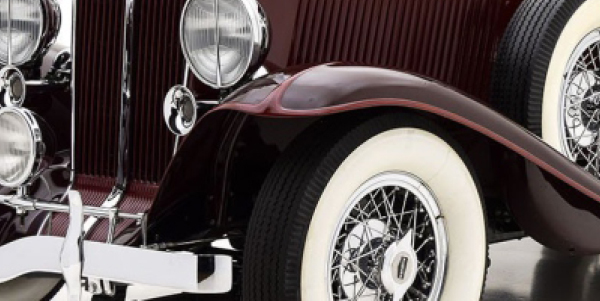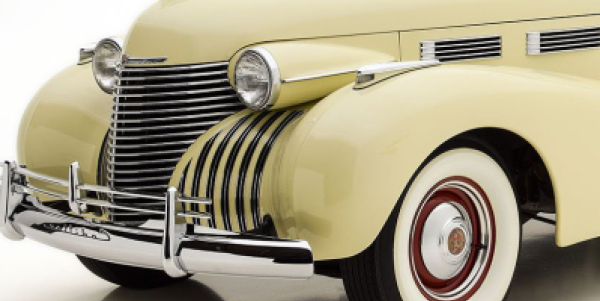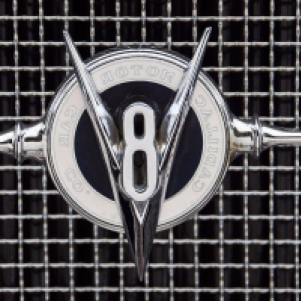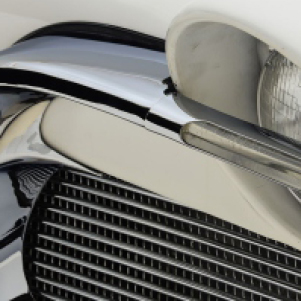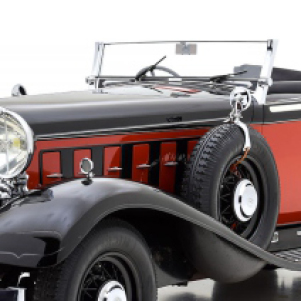
A History of The New England Region
Introduction
The Classic Car Club of America was only two years old when the New England Region was founded in 1954. Four other currently active regions were founded that same year.
As you will see when you read our story, the road was not always smooth. We weathered a split into two separate regions in 1962 and our region almost dissolved in 1985. But we managed to persevere, thanks to the dedicated people who served as Regional Directors and as members of our Board of Managers and to those whose tremendous efforts gave us the wonderful activities that we so much enjoy. Without those folks there would be no story to tell.
Much of the material for this history came from regional publications as well as from recollections of people who were members in the early days. We are fortunate to have most of the various publications going back almost to our region’s founding. In the early days Betty Barrows was the editor and her humorous anecdotal comments were delightful to read.
A History of the New England Region
The New England Region of the Classic Car Club of America was officially chartered on October 6, 1954.
The first national CCCA Directory was published in early 1954 and it lists the New England Region as a “Region Under Organization” with Joseph Masters as the Organizing Chairman. This seems to indicate that the organizers had begun their efforts within a year or so of the CCCA having been founded. The organizers were Joe Masters, Dave Bigelow (who served as Secretary) and Basil Scully. Also actively involved in the founding were F. Lawton “Doc” Barrows, S. Prestley “Pres” Blake, Tom Mix, Dick Lunsted, John O’Shea and Dick Warren. Dave Bigelow became the first Regional Director. The territory of the New England Region was Massachusetts, Rhode Island, Connecticut (except for the southwestern corner), Maine, New Hampshire and Vermont.
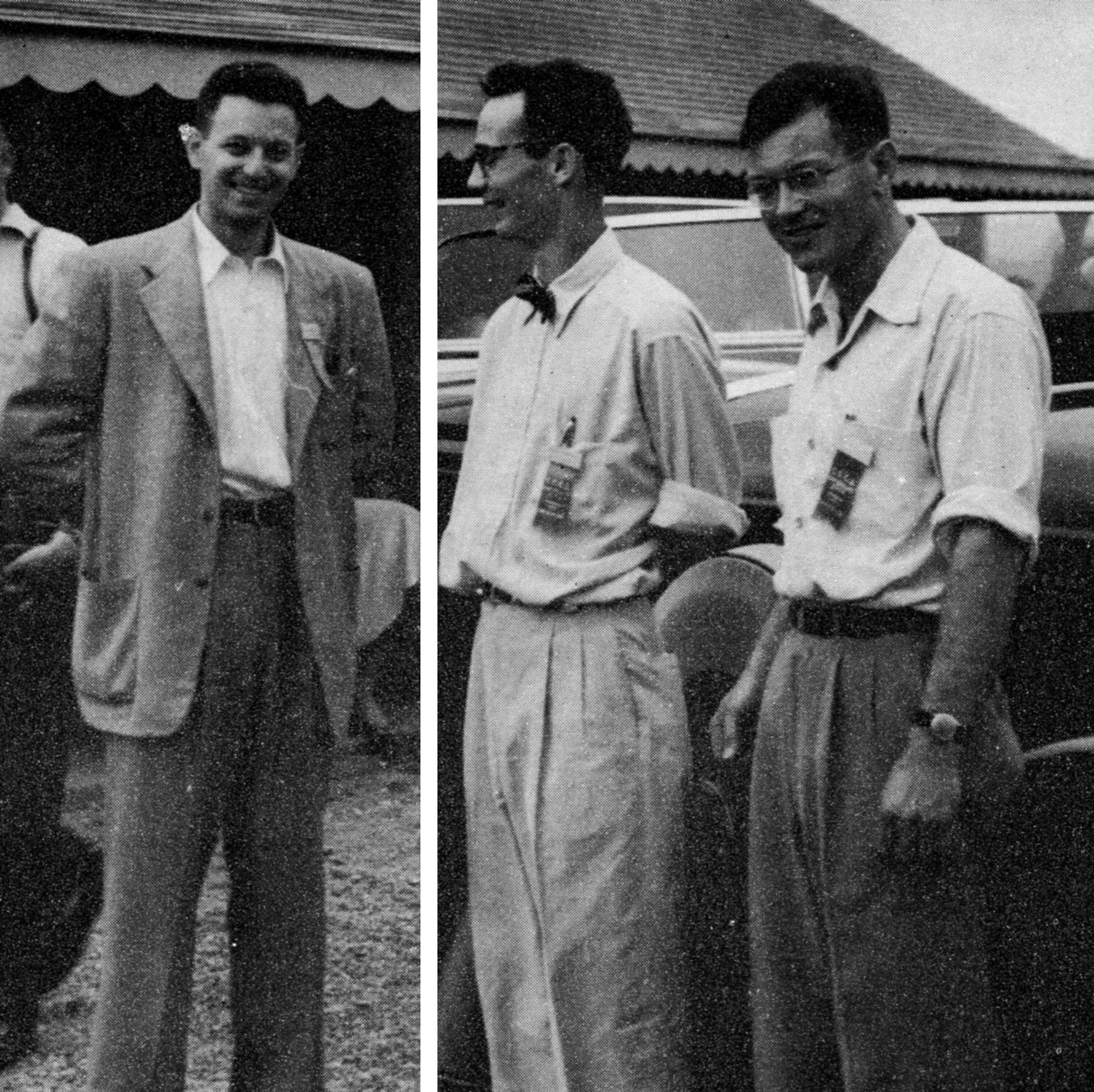
The three organizers of the New England Region
left to right:Joe Masters, Dave Bigelow and Basil Scully.
The New England Region was the twelfth region chartered by the CCCA and the fourth and last chartered in 1954. Of the eleven older regions, three had already ceased to exist by 1954 while the other eight are still active.
When first chartered, the New England Region obviously had a number of members who most likely had participated in antique car activities as a group prior to the formation of the region. While still a “Region Under Organization,” the New England Region held their first meet on June 13, 1954, in Templeton, Massachusetts, which was noted in a couple of places as being the official founding of the New England Region. Dave and Priscilla Bigelow set up the Templeton meet. From a couple of poor-quality pictures, it appears to have taken place on the grounds of a school. There were 19 cars and 30 members present – a rather respectable turnout for a new group.
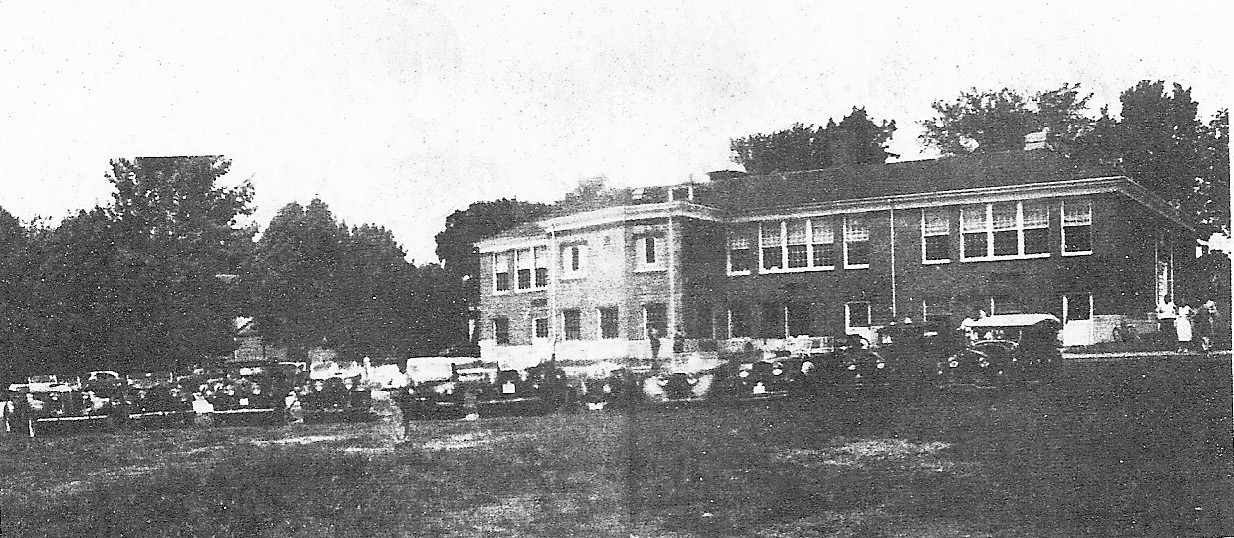
The first New England Region meet held on June 13, 1954, in Templeton, Massachusetts.
The new region published its first directory in 1955. There were 56 members: 44 in Massachusetts, 5 in Rhode Island, 3 in New Hampshire, 2 in Connecticut, 1 in Missouri and 1 in Canada.
In July of 1955 the region acquired its first clubhouse and at that time it was the only region to have one. According to a Regional Review in an early issue of “The Classic Car” magazine, the New England Region clubhouse was the envy of the rest of the national club. The first building was located in Lexington, Massachusetts, and it contained a club room and a large area for car storage. It also included a work bay where members could work on their cars. Weekly Wednesday evening social meets took place at the clubhouse during the warmer months and it was often a starting point for various tours and events. The region was to occupy three different clubhouses between 1955 and late 1976. The clubhouses will be further discussed later in this history.
Dave Bigelow was a tireless organizer who was probably one of the most enthusiastic members of the region. He quickly came to the attention of the national CCCA and in 1955 he was elected to the Board of Directors and then was promptly made National Activities Chairman. Sadly, Dave did not live to enjoy the fruits of his efforts for long and he died at age 25 from Hodgkin’s Disease on November 28, 1955. At the time of his death, Dave owned at least a dozen Full Classics® and had owned, by at least one account, about a hundred antique and collectible automobiles. One of the most prestigious Regional Awards given at the National Annual Meeting is named after him. Doc Barrows took over as Regional Director upon Dave’s death.
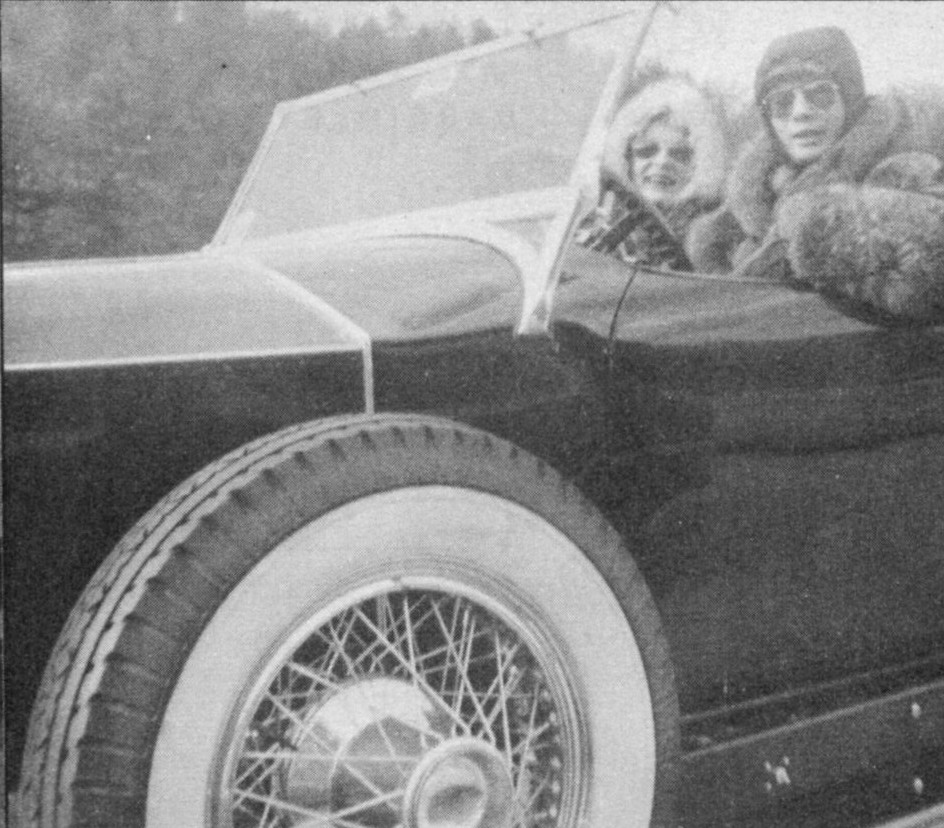
Priscilla and Dave Bigelow in their Rolls-Royce.
Despite the great loss of Dave Bigelow, the New England Region continued to be very active. A couple of popular meets became annual affairs. One was the June meet at the Princeton Auto Museum in Princeton, Massachusetts. This event traditionally included a tour up Mount Wachusett, followed by dinner at a nearby restaurant, tavern or inn, preceded, of course, by a “Restoration Hour” in the bar. This was usually an overnight event.
Another annual region tradition was the overnight Fall Foliage Tour. The first Fall Foliage Tour took place on Saturday and Sunday, October 9 and 10, 1954. The route was up through the White Mountains of New Hampshire, ending at Lake Winnipesaukee. The Speedway Petroleum Company of Fitchburg, Mass., provided free gas and oil to the participants! Saturday night was at Thayer’s Hotel in Littleton, New Hampshire. This old hotel is still in business, though it’s now called Thayers Inn (with no apostrophe). In 1954, the rates were $3 per person for a room without a private bath, $4 per person for a room with a bath and $6 per person for a two-room suite with a living room and a bath. Dinner prices ranged from $1.75 all the way up to $4.50. My, how times have changed!
The Fall Foliage Tours quickly garnered a reputation as the tour to attend and they attracted CCCA members from all over the east coast. This was a favorite event for a number of national CCCA officers like Bob Turnquist and George Jepson. In the Winter, 1957, issue of “The Classic Car”, Bill Stuhlman wrote an article about the 1957 Fall Foliage Tour in which he noted that at the Saturday banquet, “President Turnquist, clearly impressed with the region and the tour, was introduced and said as much.”
Another regular event held by the region was the Rallye which was a competitive event usually based on speed and time. However, at least one was more of a fun event that was based on locating a series of signs, markers and monuments. Scores were based on correctly identifying all the clues and on the lowest mileage in accomplishing this. Following the completion of this type of Rallye, dinner was held at a secret place that participants had to find based on clues in the directions.
The year 1958 was a good example of just how active this young Region was. In addition to the weekly Wednesday evening get-togethers, they held three dinner meetings, five one day events in different parts of the Region and two overnight tours. Reading the reports of these various events and tours in these early years, it’s apparent that members frequently brought their children along – something rarely seen today.
In 1958, the national CCCA put on a CARavan, the New England Circle Tour, from August 18 through 23. It began and ended in Westchester County, New York, but the bulk of the tour took place within the territory of the New England Region. A number of New England Region members took part in this CARavan which proceeded east along the Connecticut shore to Newport, Rhode Island. From there it continued east and up the coast of Massachusetts, through Boston, and on to Portland, Maine. It then snaked west to Burlington, Vermont, then south through Williamstown, Massachusetts, and ended in Tarrytown, New York.
Beginning in 1959 or 1960, the region published a monthly newsletter titled “The Nor’easter” which usually contained 5 or 6 pages with notices of upcoming activities, reviews of past activities, news about members and news about goings on at the clubhouse. These newsletters were produced by Editors Doc and Betty Barrows. Doc and Betty were ever mindful of regional finances and the need for economy and at least one page in several early newsletters was printed on the backs of obsolete judging forms. Doc and Betty were two spark plugs in the New England Region and they organized a number of events and attended virtually every activity except when they were in Florida for the winter.

Doc and Betty Barrows who greatly helped maintain regional momentum for over 20 years. Behind their 1932 Lincoln is the first regional clubhouse in Lexington, Massachusetts.
In 1956, the New England Region developed a badge that members could display on their Full Classics to promote cohesiveness and camaraderie as well as to advertise the region. The badge was in the shape of the New England states that were within the regional territory and each state had a different enamel coloring. These badges are quite scarce today.
In the mid-Fifties an informal subdivision of the region developed. It was known as the Lexington Group and the people associated with it came from the area west of Boston where the clubhouse was. Such a group within the region caused some resentment among other members and some people even referred to this group as a clique. At the same time a number of members from Connecticut and the western part of the region began making noises about forming their own subdivision or possibly even a separate region. Their complaint was that, for the most part, the region’s activities took place in the eastern and northern part of the region plus all the weekly Wednesday evening social gatherings were held at the clubhouse or at members’ homes in eastern Massachusetts. Consequently, it was difficult for people from the southern and western reaches to participate in regional events. The push for a new group or region was spearheaded by Russ Brunen, Dick Waddams and a few others. Unfortunately, this effort to break away from the New England Region resulted in a good deal of rancor and dissention amongst some regional members. In early December of 1961, discussions were held with national CCCA officials who agreed to form a new region within New England. The new spinoff region was named the Southwest New England Region and its territory was Connecticut, Rhode Island and Massachusetts west of Worcester. Russ Brunen became the first Director of the Southwest New England Region. The original New England Region retained as its territory Massachusetts east of Worcester, Maine, New Hampshire and Vermont. The new name for this region was the Northeast Region.
The Southwest New England Region was initially quite active. They held a number of successful activities, one of which was a car show and swap meet in Willimantic, Connecticut, organized by Russ Brunen. In 1962 they had a new newsletter with Anson Thorpe as Editor. In the same year they had a record high attendance on a tour to Kennebunk, Maine. In 1963 Dick Wadhams became the new Director and Nelson Pease became the new newsletter editor. In the fall of 1963, the newsletter was named “The Steering Wheel”. In 1964, the Northeast Region was invited to join the Southwest New England Region at a weekend meet in Milford, Connecticut, on November 21 and 22 where the Saturday evening program was to be the playing of a tape of Ray Dietrich’s reminiscences of the Classic Era which he delivered at the annual meeting at Buck Hill Falls the previous winter.
September 16 and 17, 1967, was the first Annual Antique & Classic Car Meet at Bennington, Vermont. The Northeast Region became one of the sponsors and touring up to this meet in mid-September would replace the Fall Foliage Tour for the next three years.
As with many organizations, the Northeast Region had its ups and downs. In the November, 1966, issue of “The Nor’easter” newly elected Director Harry King noted in his remarks that the membership of the Northeast Region had been declining over the past few years. Also, member participation in activities was down. Harry blamed the decline partially on a recent nasty political wrangle within the national CCCA and partially on the fact that there were more and more antique car events on the calendar that conflicted with the region’s activities. Harry wrapped up his remarks by stating that he would sponsor a trophy to be given to any member who attended six meets with a Classic during the following year. However, no mention of such trophy appeared in subsequent newsletters.
Nevertheless, the number of activities did not seem to decline for in 1967, for example, the region had planned no fewer than eleven events, at least three of which were overnight tours. However, the decline in the number of people participating in activities continued through the end of the decade. The April 1970 issue of “The Nor’easter” contained an editorial bemoaning this disturbing trend. It noted that there were about fifteen families, “The Faithful Fifteen,” who could be counted on to attend several activities every year while the rest of the seventy-three members were never seen. The editorial noted that back in the Fifties and early Sixties, twenty or more Classics were seen at every driving event whereas lately a well-attended meet had only six or seven out of a total of 146 Classics owned by regional members. While the Board asked the members several times in the past what sort of activities with cars they would like to see, no responses were received. Furthermore, the same few people had held positions of responsibility for a number of years and new blood was sorely needed. Despite numerous pleas for volunteers, nobody new came forward.
The early issues of “The Nor’easter” are very interesting to read. They not only contain information about upcoming events and reviews of past events, they also had news items about people in the region and what they were up to. Some are informative and others are rather humorous. Here are some examples.
- The August 1962 “Nor’easter” reported that Doc Barrows was in the process of painting his 1931 Lincoln with Rustoleum “to remove rust and make it all black.”
- The March 1964 “Nor’easter” reported that the clubhouse had about 3,000 license plates in the region’s collection.
- The July 1964 “Nor’easter” noted the progress Doc Barrows was making on his 1948 Lincoln Continental and said that it “now needs only a little more work to make it a 30 point car.”
- The February 1966 “Nor’easter” proclaimed that Tom and Helen Mix had a color TV!
- The June 1967 “Nor’easter” announced that Pat Young established a trophy – The Pat Young Award – to be presented annually to the person who has done the most in restoring a Classic that year. The recipient kept the award for a year and then returned it to the region for presentation to the next recipient. The region is still in possession of this trophy.
- An editorial in the April 1969 “Nor’easter” said, “It is interesting to note how many die-hards of the Veteran motor cars are now leaning on Classics for Club activities and good fellowship. From an automobilist’s point of view many of the cars before 1929 are not safe on the roads of today. You must be extremely brave or foolhardy to move with today’s traffic depending on two-wheel mechanical brakes. It is clear to members of other clubs that touring in a Classic is the only way to travel.”
- In this same issue it was also noted that a third mimeograph machine was just donated to the region and “perhaps we should discard some Continentals and concentrate on mimeographs.”
- The September 1969 “Nor’easter” contained a report on the tour up to the Bennington Meet. “First on the program was the drive up through the beautiful countryside in time to get settled and to attend the cocktail party at 7:30. This was free, compliments of the Bennington Merchants. Strangely enough this was held in the Parish House of the Episcopal Church. The party was so lavish that we forgot all about supper until much later.”
As the decade of the Seventies began, the Northeast Region remained active despite the challenges of declining participation. In October of 1970, the previously popular Fall Foliage Tour was reinstated. This tour had been discontinued in 1967 when the region assumed a sponsorship role in the annual meet held in September in Bennington, Vermont. The weekly Wednesday evening social meetings continued to be held at the clubhouse in warmer months and at various members’ homes in the winter, although attendance continued to decline.
In early 1970, Doc Barrows, who had been a prime mover in the region since its inception, suffered a major heart attack. He had a bad time for several days, but soon was on the mend. By June, he was back at his dental practice in Boston three days a week.
In spite of a slow but steady decrease in member participation, the region continued to hold frequent meets and tours. However, the October, 1978, tour over to Martha’s Vineyard was indicative of the participation problem when only a disappointing 16 people showed up, several of whom came for only part of one day. Only four Full Classics® were there.
The Southwest New England Region experienced similar problems, but they were not able to overcome them and by 1976 that region was defunct and its territory reverted to the Northeast Region. They had been inactive for a while and hadn’t had a Director since 1974. On March 1, 1976, Northeast Regional Director Harry King sent a letter to its members inviting them to join the Northeast Region.
In early 1981, the National CCCA asked the Northeast Region to host a Grand Classic in July of 1983. Dick and Bea Dewey hosted a meeting at their home on May 17 to discuss this. This was the first ever Grand Classic in the northeast and it was held on July 9, 1983, at the Sheraton Tara Hotel in Framingham, Massachusetts. There were 60 Full Classics® present with 42 judged and 18 in exhibition.
Despite having organized and conducted a successful Grand Classic, the Northeast Region was barely limping along and serious discussions were held about disbanding the Region. Things did not improve and the Wednesday evening gatherings, which had become rather sporadic by that time, were discontinued altogether because of lack of interest. Then in the spring of 1984, members received postcards announcing that the Annual Meeting would be held that March (it should have been held the previous November) and that the sole item of business was to decide if the Northeast Region should be disbanded. A number of people fully expected that the decision would be in the affirmative.
Only a few members attended the meeting and discussion was lively. A vote was taken and the result was in favor of continuing the region for at least the time being. However, no replacements could be found for those regional managers whose terms had expired, so the existing Board was persuaded to stay on temporarily. A committee was formed to explore what to do with the region.
When the exploratory committee met, there was, as expected, a continuation of the discussion about whether to disband. Attending that meeting was relatively new regional member and past National President Charlie Kerner, who, with his wife Peggy, had recently moved to New Hampshire from New Jersey when Charlie retired. Charlie believed that the Northeast Region could become successful again if it were to offer activities that Classic car owners wanted. Charlie was not about to let the region die and at that meeting he committed himself to bringing it back. The Board of Managers agreed that Charlie should do what he could and they elected him Regional Director, succeeding Harrison Bridge. Charlie then recruited a few dedicated members who were willing to work with him to achieve his goal. One of those dedicated members was George Holman who became Assistant Director. George worked to groom new people for the Board and there were a number of enthusiastic members who stepped up. Gradually these new people replaced a lot of the old guard who were no longer active.
The committee that organized the Grand Classic in 1983 then evolved into the new Regional Board of Managers. These dedicated Board members succeeded in attracting additional Board members who were equally committed to working for the success of the region. Enthusiasm was such that willing and able people stepped up to put on another Grand Classic in Newport, Rhode Island, a mere two years later.
Following through on Charlie Kerner’s belief that the region could thrive if it offered activities that appealed to Classic Car owners, George and Mary Jeane Holman put together the first local regional activity held after the region began its comeback. It was a tour that took place on Saturday, May 17, 1986, which began and the Holmans’ home in Wilbraham, Massachusetts. After the usual morning refreshments, the tour left for Pres Blake’s car collection in Somers, Connecticut. After plenty of time to enjoy the collection and the lovely grounds, a sumptuous buffet lunch was served. Back in those days, even beer was available! After lunch, the group motored over to Jon Abrahamson’s restoration shop in Enfield, Connecticut.
An amazing transformation quickly took place as the Northeast Region roared back to life under the leadership of a number of enthusiastic and energetic leaders. Soon planning was underway for another Grand Classic to be held in July of 1987 in Sturbridge, Massachusetts. As soon as this highly successful Grand Classic was relegated to the record books, someone suggested “Why not host a CARavan?” This would be the region’s first CARavan. (It has been said that the region hosted three prior CARavans: the 1958 New England Circle Tour, the 1968 Colonial Heritage CARavan and the 1978 New England Countryside CARavan, however these CARavans were managed by the National CCCA.) Scheduled for September of 1990, this Northeast Region CARavan was named The September Morn CARavan. The managerial spark plug behind the organization and planning effort was Mary Jeane Holman assisted by such stalwarts as husband George, Ron Siff, Jon & Sandy Lee, Chris & Heidi Charlton, Pete & Judy Howe, and Charlie Kerner. The CARavan started in Gloucester, Massachusetts; then proceeded on to Portland, Maine; then North Conway, New Hampshire; and ended in Burlington, Vermont. At the time a number of veteran CCCA CARavanners said that this was one of the best CARavans ever.
But even after the huge effort to organize and conduct this extensive CARavan, the Northeast movers and shakers immediately launched into preparations for a Grand Classic to be held in July of the following year in Waterbury, Connecticut.
As time went on, more people became interested in organizing events. Two- and three-day tours were quite popular and destinations included Martha’s Vineyard, Nantucket, Gloucester, the Hudson River Valley, New Hampshire, the Berkshires, Cape Cod and Rhode Island, to name only a few. As more quality activities were organized, the membership began to increase dramatically, proving that Charlie Kerner was right.
The region quickly gained a national reputation for putting on first class activities and CCCA members often traveled considerable distances to attend. This was especially true for national events (CARavans and Grand Classics) that the region hosted. Perhaps it’s fitting that at the 1990 Regional Annual Meeting the Northeast Region changed its name back to the New England Region, the original name under which the region first gained a reputation back in the Fifties and Sixties for having quality events.
Tragedy struck the New England Region on March 18, 1995, when Mary Jeane Holman died and we lost one of our region’s most enthusiastic and friendly members. Shortly after her death, three dear friends of Mary Jeane’s – Betty Hull, Aneice Lassiter and Drena Miller – proposed a new National Award to recognize a CCCA member who exhibits Mary Jeane’s truly selfless classic spirit that had so much positive impact on so many people. The New England Region Board of Managers embraced this idea and the result was one of the most meaningful CCCA awards – The Classic Spirit Award. The actual award was an original piece of art and it was funded jointly by the Holman family and the New England Region. The Classic Spirit Award was retired in 2023.
Among the numerous overnight events, two became regular affairs and deserve special mention. One was an annual weekend in Gloucester, Massachusetts, which coincided with the terrific Concours d’Elegance and Hill Climb put on by the Vintage Sports Car Club of America (VSCCA) at the old Crane estate in Ipswich named Castle Hill. We usually stayed at the Bass Rocks Motor Lodge in Gloucester which is located directly across the road from the ocean. These special weekends took place from 1997 through 2002 which was the last year for the Castle Hill Concours.
Another regular event was the annual Vintage Celebration held at regional member Bob Bahre’s New Hampshire International Speedway. While this was not a NER event as such, these weekends became a regional tradition with members gathering to socialize in the infield garage space used by George Holman and Jon Lee and to watch the vintage racing. On one of the evenings, we usually had a group dinner for regional members at a local restaurant. Members helped by displaying cars and by judging in the Concours d’Elegance called “The Elegance.” On the evening before The Elegance, Bob Bahre hosted a full course Turkey dinner with open bar for those involved in judging and/or showing cars. On the day of The Elegance, Bob’s double skybox was open all day for the participants and was well stocked with complimentary food and beverages of all sorts. The Elegance was discontinued after 17 years in 2008 when Bob sold the race track.
By 1995, regional management was ready to put on another CARavan which was scheduled for 2001. This one was to be entirely within the state of Maine and was called the DownEast CARavan with the slogan of “Beyond Portland and L. L. Bean.” It began in the mountains of western Maine, then moved to the coast in Rockland and ended in Bar Harbor. The planning committee decided to limit participation to 90 cars, but registrations significantly exceeded that number. Not wanting to turn anyone away, the planners scrambled to modify the arrangements and we were eventually able to accommodate everyone who wanted to go. The final numbers were 145 cars and over 300 people. This CARavan was a huge success despite the horribly tragic event of 9/11 which occurred in the middle of the CARavan and directly affected a number of participants.
In addition to offering activities that members want, quality publications are another important part of creating and maintaining a successful region. Prior to 1980, the region produced a regular newsletter titled “The Nor’easter” edited by Doc and Betty Barrows. However, this publication fell by the wayside in the late Seventies. When the region’s resurrection began in the mid-Eighties, the only publications were occasional notices of upcoming events. Then in 1989, Heidi Charlton took over as Editor and resurrected “The Nor’easter” newsletter.
Jon Lee assumed the duties of Editor in 1991 and he soon launched a true magazine in addition to the regular news bulletin. The new magazine was named the “NER Illustrated Quarterly” which was soon renamed the “New England Classic Quarterly” for the First Quarter, 1992, issue. In 1995 Fred Roe took over as editor of the bulletin so Jon could focus on the magazine. In 1997 Fred also assumed editorship of the “New England Classic Quarterly” which remained in his capable hands until 2002. Fred introduced color interior pages in the Second Quarter, 1999, issue and a color cover on the First Quarter, 2000, issue.
Sometime in the late Nineteen Eighties, the region reinstated its merchandise program to help raise funds. One of the early items was a newly manufactured generator strap that fit a number of Full Classics®. Other items marketed over the next several years included shirts with the CCCA logo, fender covers and hitch receiver covers.
The New England Region has remained one of the most active CCCA regions has hosted numerous regional activities as well as several significant national events. In addition to Technical Seminars, Judging Seminars and weekend tours, the region has hosted several major events including three CARavans, twelve Grand Classics and one National Annual Meeting.
When it came to Grand Classics, the region planned two or three days of other activities to provide an incentive for people to attend so they could enjoy more than just a single day of judging. This approach proved to be quite popular and increased participation.
Technical Seminars also proved quite popular. Begun as the brain child of Ernie Cormier, the region began a tradition of inviting members of other antique car clubs in the area to participate and a good percentage of participants have been from other clubs. The New England Region has picked up several new members from these people.
Of particular note is the 2006 National Annual Meeting that the New England Region hosted in Boston from January 4 through 7. It was with considerable trepidation that the region’s management undertook the planning for this major event because all it would take to turn it into an unmitigated disaster would be a typical January New England snowstorm! However, the weather could not have turned out better and the event was a tremendous success.
One recent major event was the Classic New England CARavan from September 9 through 17, 2016. This CARavan took place in New Hampshire and Maine and was one of the best attended CARavans ever. Accommodations were first class all the way and the tour routes were perfect for antique cars. Of course, the food was terrific! A number of veteran CARavanners remarked that this was the best CARavan they had attended.
The following are the National activities that the New England Region has hosted since its founding:
- July 9, 1983: Grand Classic in Framingham, MA
- July 12 & 13, 1985: Grand Classic in Newport, RI
- July 10 & 11, 1987: Grand Classic in Sturbridge, MA
- September 14 – 22, 1990: September Morn CARavan
- July 12 & 13, 1991: Grand Classic in Waterbury, CT
- July 9 & 10, 1993: Grand Classic in Westboro, MA
- July 11 & 12, 1997: Grand Classic in Portland, ME
- July 6 – 8, 2000: Grand Classic in Sturbridge, MA
- September 7 – 15, 2001: Downeast CARavan in Maine.
- July 8 – 10, 2004: Ocean State Grand Classic in Warwick, RI
- January 4 – 7, 2006: Annual Meeting in Boston, MA
- July 9 – 12, 2008: White Mountains Grand Classic in Bartlett, NH
- July 14 & 15, 2012: Grand Classic in Rockport, MA
- September 9 – 17, 2016: Classic New England CARavan
- September 5 – 8, 2018: Grand Classic & Mini-CARavan on Cape Cod
- June 15- 18, 2022: Pilgrim Grand Classic & Mini-Caravan on Cape Cod
New England Region Clubhouses
From the beginning of the New England Region in 1954, many members felt they needed a facility that could be used for car storage, for working on cars, for a regional headquarters and, perhaps most importantly, for socializing. Such a facility was called the clubhouse. The region had three clubhouses over a 21 year period and all were rented facilities. The first was acquired in July of 1955 and was located in Lexington, Massachusetts. The Autumn 1955 issue of “The Classic Car” noted that the New England Region “recently found a new Clubhouse or garage for storing their classics – actually it’s an old cow barn they’re fixing over.” During this same period, it was noted at the national level that a regional clubhouse was quite rare. Most likely the NER clubhouse was the only one and it was the envy of the other regions.
The Lexington clubhouse had a club room for socializing and space to store several cars as well as a space to work on cars. Car storage cost $5 per month. Sometime in the fall, the Region held its first meet at the new clubhouse and 28 members attended. It had previously been decided that the weekly social gatherings would be held on Wednesday evenings and the clubhouse was an excellent place for these meetings in warm weather. It seems that everyone who attended the Wednesday evening meetings had a great time because eventually they had to be terminated at 10:00 p.m. due to complaints from the neighbors about the noise! The clubhouse was also an ideal place for meets and as a kick off location for driving tours.
By 1959, however, the owner of the building decided to develop the property which would require the demolition of the clubhouse. Another cow barn was subsequently located in Needham, Massachusetts, which would serve as the second clubhouse. This barn had a concrete floor with troughs in it (after all it was a cow barn!) which had been filled with sand to make the floor more or less flat. The heavy Classics tended to become mired in the soft sand, so moving cars around proved to be rather difficult. However, the building did have a nice room in the front which made a very satisfactory club room. Perhaps best of all, there were no neighbors close by, so there was no longer a need for a 10:00 p.m. curfew on Wednesday evenings. The owner of the barn was a Mr. Mahoney who was quite friendly and often dropped by to chat when the social gatherings were underway.
Mr. Mahoney had a contracting business and in February of 1963 he told the region they would have to vacate their clubhouse by June as he needed the space for his equipment. So, a new building would have to be found rather quickly because considerable time would be required to move not only cars that didn’t run (a couple didn’t even have wheels) but also a large quantity of parts and other various paraphernalia. To further complicate the process, there were a number of requirements for the new clubhouse, among them sufficient room for members’ cars, a large enough club room, ample parking space outside and a satisfactory distance from potentially complaining neighbors. Ads were placed in newspapers and realtors were contacted, but suitable prospects were not readily forthcoming. June rapidly approached and it became clear that the region would not be able to meet Mr. Mahoney’s evacuation deadline. Fortunately, Mr. Mahoney was very understanding and he graciously extended the deadline.
Finally, in July a building was found in Harvard, Massachusetts, that would turn out to be the best clubhouse by far. The building was on a farm owned by the Stone family who also operated an ice cream stand a short distance from the new clubhouse. This new and improved clubhouse had all the attributes the region could hope for:
- A cooperative and sympathetic landlord
- Room for 7 cars on a concrete floor (one space to be used as a communal work bay) and room for 20 more on a dirt floor
- An adequately spacious club room
- Plenty of outdoor parking for the Wednesday night socials, meets and gatherings for departures on tours
- An ice cream stand nearby to enhance the Wednesday evening socials, and
- A location that could be used as a mailing address for regional business.
The rent for the building was $85 a month which allowed the region to charge $6 per month for a storage space on the concrete floor and $5 for one in the dirt floored section.
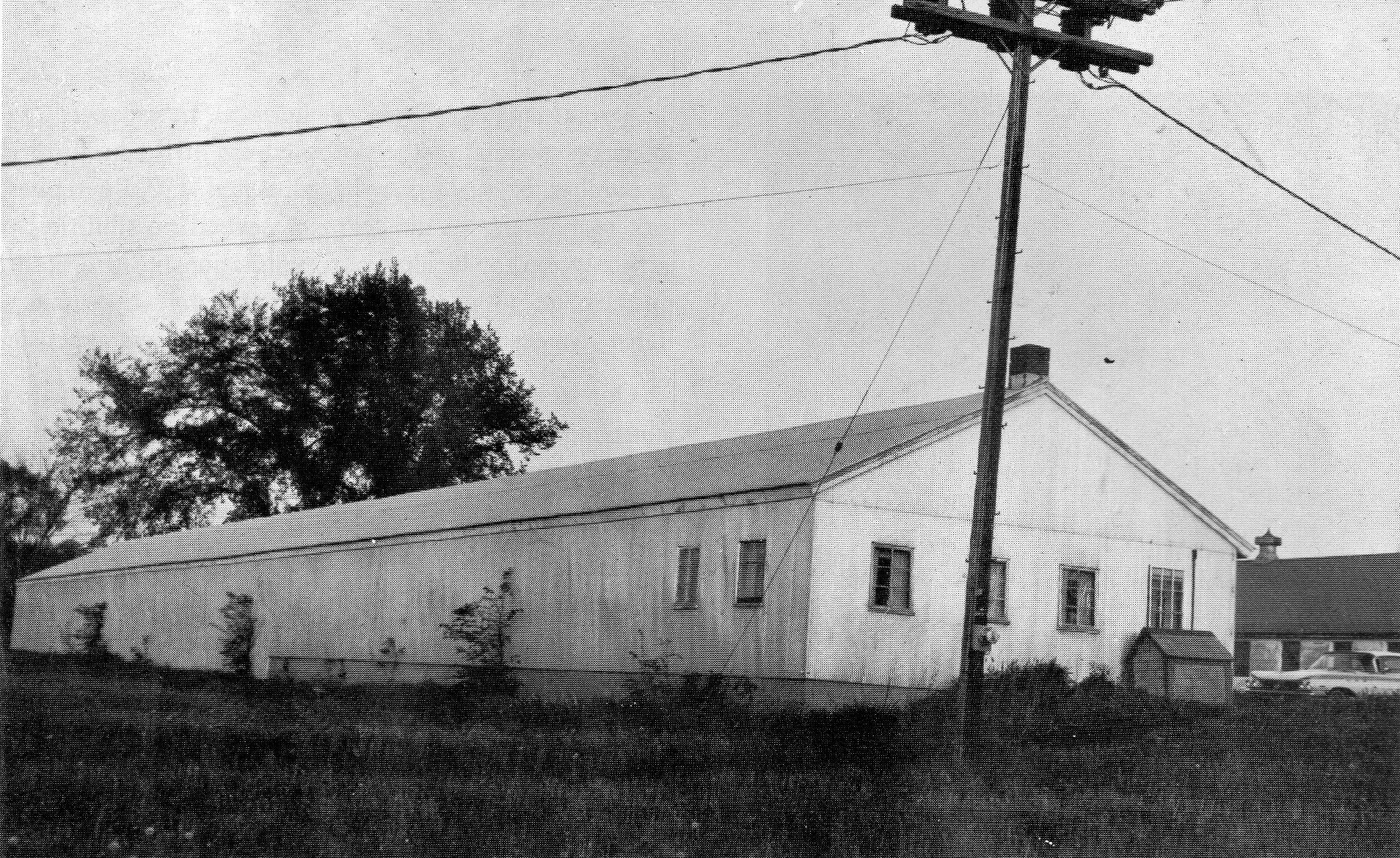
The third clubhouse in Harvard, Massachusetts. The club room was in the near end of the building with the windows. This is the only picture we have of any of the clubhouses.
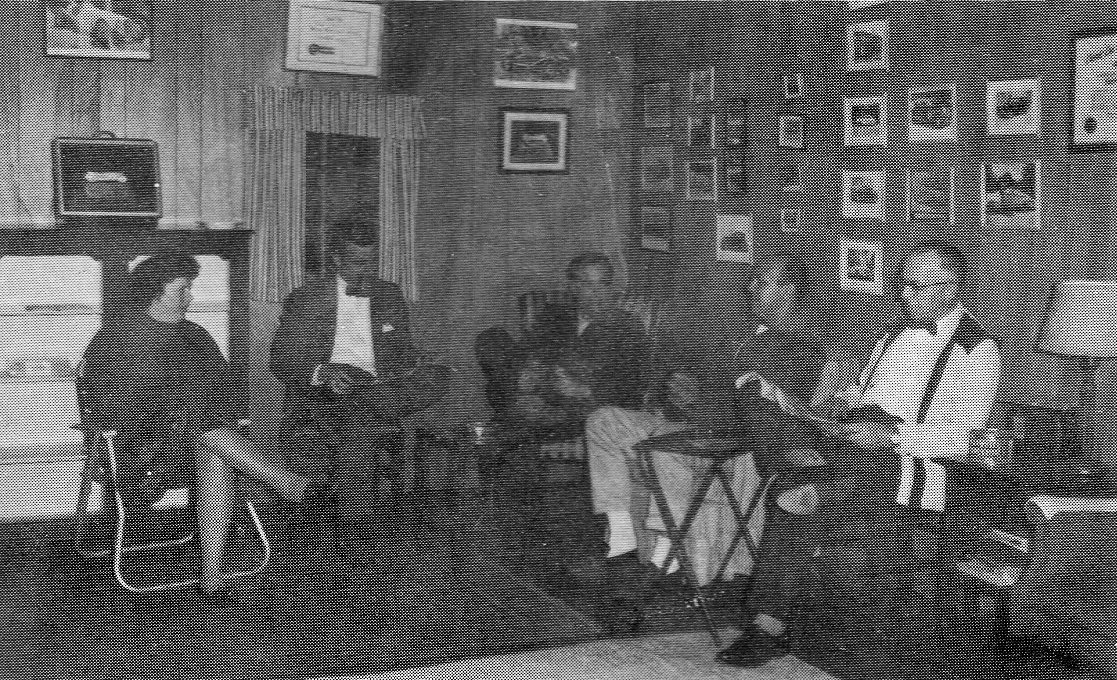
A Wednesday evening social in the club room.
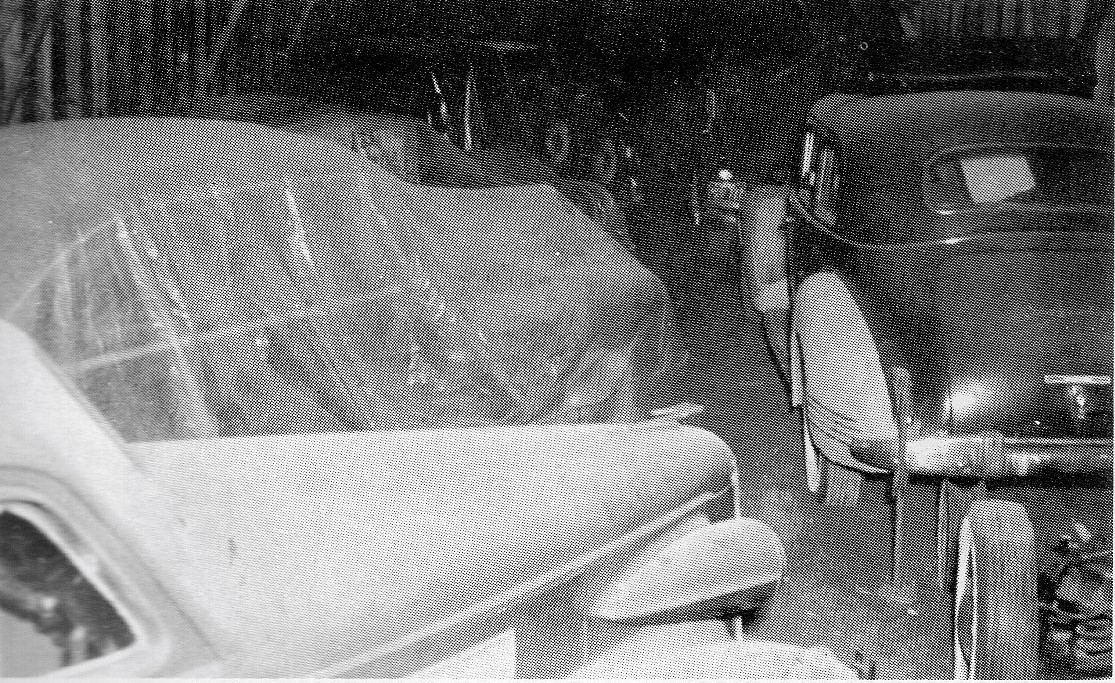
The storage area with the dirt floor.
Improvement plans were quickly drawn up and Regional members went to work on their new facilities. “Mahogany” paneling and a ceiling were put up in the club room and a door was cut through to the adjacent work bay. Curtains were hung, the floor was painted, the chimney was repaired and a wood burning stove was installed. A good deal of furniture was donated including a large china cabinet for displaying various regional trophies, emblems and other memorabilia. The March 1964 issue of the “Nor’easter” noted that “The seats of the three wooden chairs have been recovered with genuine pink plastic.” The region’s extensive collection of license plates was tacked up on various walls. Later an air conditioner was acquired.
Many improvements were also made to the storage areas. The work bay received a work bench, vice, air compressor, floor jack, creeper and an assortment of tools. This area could be reserved by members who needed an area to work on a car. There was a one-month limit for the use of this space. Meanwhile, electrical outlets were placed opposite each stall in the concrete floored area and adequate lighting was installed in the entire building. Sturdy hooks and locks were put on all doors.
In his article about the clubhouse which was published in the Fall 1964 issue of “The Classic Car”, Bayard Guild noted that:
“Perhaps . . . the greatest advantage in possessing a fine regional headquarters is found in the interest and pride of the members who belong to something tangible and have a place to meet friends; a show place for important regional accomplishments, and a place to take the potential new member or out-of-town member – in short, a ‘home’ for the region.”
But having the clubhouses was not beneficial for all regional members. While the locations were central and easily accessible for many members, they were not convenient to a number of others who lived outside the immediate area. These members consequently felt excluded because it was not practical for them to attend the Wednesday socials and other events that took place at or departed from the clubhouse. During the period of the first clubhouse, the members who promoted regional activities in and around this headquarters were referred to as The Lexington Group. Some members even referred to these people as “cliquish.” This situation resulted in a fair amount of unfortunate rancor and ultimately contributed to the region splitting into two regions in 1962. The clubhouse remained within the territory of the new Northeast Region while the new Southwest New England Region never did have one.
After the split, the clubhouse remained very popular with Northeast Region members. The Wednesday evening gatherings continued during the warmer months and the nearby ice cream stand was most convenient. Mr. Stone, who owned the property and the ice cream stand, was very interested in the cars and in the region and he supported the region’s efforts. In fact, Mr. Stone was a regular participant in the Wednesday evening socials.
Unfortunately, Mr. Stone died in an accident in late 1966 or early 1967 and Mrs. Stone died a year later. Their sons continued to operate the ice cream stand, but nobody lived on the property after that. Then in 1972 the cow barn that was near the clubhouse burned and a few years later the empty Stone family house also burned. This left the clubhouse rather isolated and raised significant security concerns. In fact, a vagrant drug addict somehow managed to get in on a regular basis and used the club room as a rooming house. To make matters worse, the Stone son began pressuring the region to vacate the building so he could build a rentable apartment in it. Also, by this time attendance at the Wednesday evening socials had declined significantly. All of these factors combined to lead the regional management to decide that maintaining a clubhouse was no longer viable and so this, the last clubhouse, was vacated in late 1976. Loss of the clubhouse was a considerable blow to those who had come to rely on it for economical storage and a great disappointment to those who had so enjoyed the social gatherings there.
In a 1998 letter to Fred Roe, editor of the “Nor’easter”, Bayard Guild summed up the clubhouse experience in this way:
“The building generated much enthusiasm and camaraderie. The meetings there constituted a continuing education for many of us and an opportunity to tap the considerable talent which existed in that large and diverse group. All of this took place in a comfortable and informal setting, often with our cars just outside the door. . . Never-seen-before interesting Classics were constantly turning up at those meetings and there was much low-key buying, selling and trading taking place and much advice to go with it.”
New England Region Car Badges
Many car organizations offer uniquely designed car badges that members can display on their cars to promote pride in their club. The New England Region has had no fewer than four different car badge designs since our founding in 1954.
Sometime in our region’s early days, folks decided they ought to have a car badge and the final design was a rather large badge in the shape of a map of the regional territory. This badge was first made available in 1956.
After the region split into two regions in 1962, it seemed appropriate that the new Northeast Region should have a new car badge with the Northeast Region name. Several designs were considered, and the result was a rather handsome round badge that has a deep blue background with accents of red, cream and black. This new badge was available to members by May of 1963. Apparently only a few were produced, and they are quite rare today. No regional car badge was available for the next thirty years.
In 1997, seven years after the region was once again named the New England Region, a couple of members of the regional Board of Managers came up with a design for a new car badge and presented it to the Board as a regional project. The board approved it and the result was a large rectangular badge with brown, tan and white colors and the CCCA car logo. This badge is often seen displayed on New England Region Full Classics® today.
Our fourth and newest regional car badge is a slightly smaller replica of our first badge. It was designed and produced in 2015 especially for our 2016 Classic New England CARavan and one was attached to each CARavan license plate. These badges are currently available for sale to regional members.
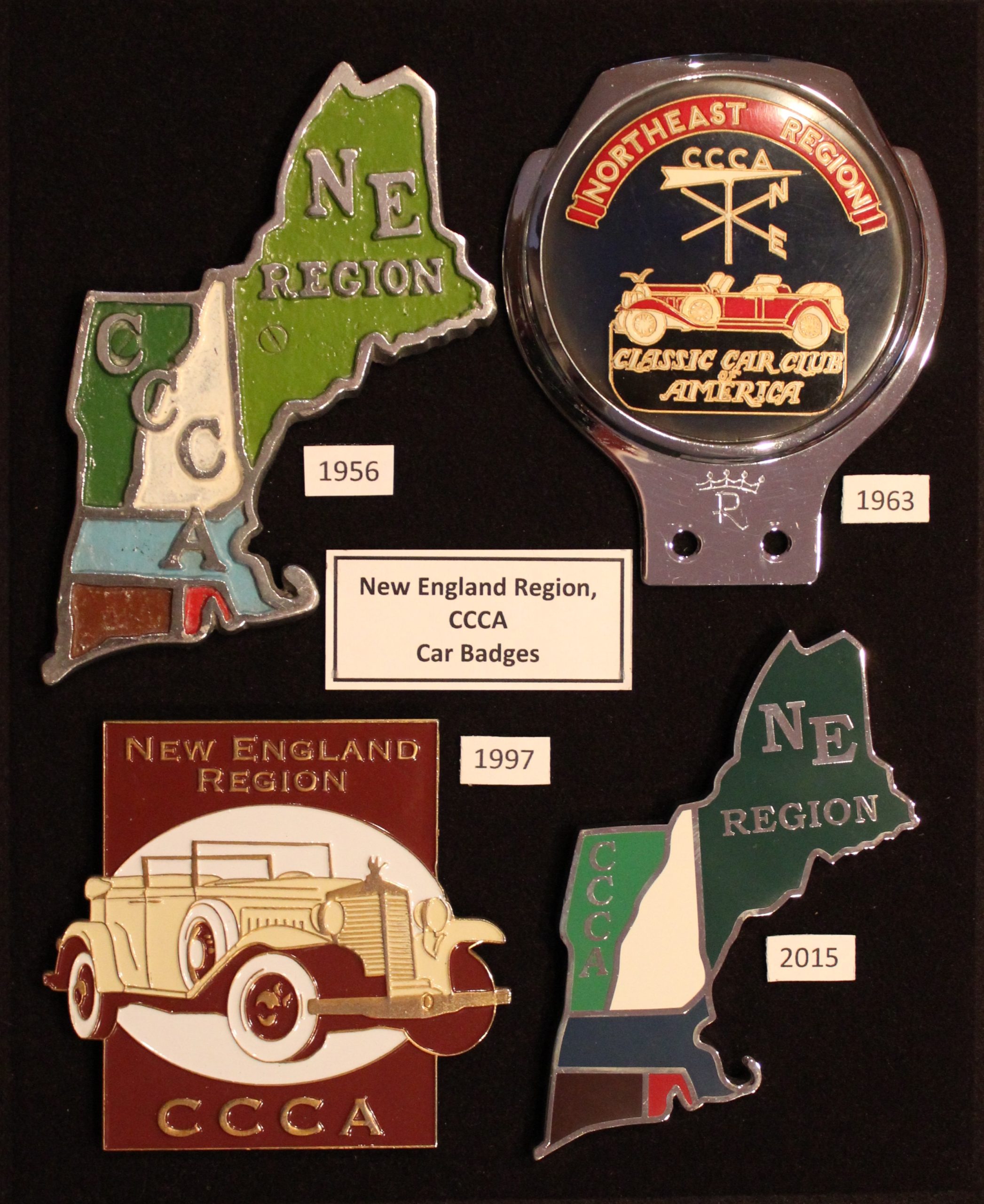
Regional Directors
New England Region
- David Bigelow, 1955
- F. Lawton “Doc” Barrows, 1956
- Arthur Mellor, 1957
- Kermit “Ted” Fosgate, 1958
- John O’Shea, 1959
- Russell Brunen, 1960
- John Fiske, 1961
Northeast Region
- Robert W. Valpey, 1962 – 1964
- Charles L. Harper, 1965 – 1966
- Harry H. King, Jr., 1967 – 1970
- Phil Dumka, 1971 – 1973
- Harrison Bridge, 1974 – 1975
- Harry H. King, Jr., 1976 – 1977
- Shelley Vincent, 1978 – 1980
- Inez Berry, 1981
- Dick Wadhams, 1982 – 1984
- Harrison Bridge, 1985
- Charles Kerner, 1986
- George Holman, 1987 – 1988
- Ron Siff, early 1989
- Jon Lee, early 1989 – 1990
Southwest New England Region
- Russell Brunen, 1962
- Richard Wadhams, 1963 – 1965
- John S. Jaczinski, Jr., 1966
- Hamilton “Tony” Lee, 1967 – 1971
- Robert Douglass, 1972 – 1973
- Thomas Doyle, 1974
New England Region
- Jon Lee – 1991
- Mary Jeane Holman, 1992
- Edgar Minnie II, 1993 – 1994
- Garth Story, 1995 – 1996
- Ron Siff, 1997 – 1998
- Frank Wemple, 1999 – 2000
- Ernie Cormier, 2001 – 2002
- Sandra Lee, 2003
- Garth Story, 2004 – 2006
- Bruce Giguere, 2007 – 2009
- Chris Charlton, 2010 – 2012
- Jack Welch, 2013 – 2015
- Chuck Niles, 2016 – 2017
- Jeff DeMarey, 2018 – present
National Presidents & Awards Recipients
National Presidents
- Frank Mulderry, 1878 & 1979
- Charlie Kerner, 1980 & 1981
- George Holman, 1998 & 1999
- Jon Lee, 2006 & 2007
Katie Robbins Distinguished Service Award Recipients
- Charlie Kerner, 1986
- Lee Davenport, 1991
- Frank Mulderry, 1999
- George Holman, 2002
- Frank Wemple, 2004
- Jon Lee, 2009
Classic Spirit Award Recipients
- Lee & Ann Davenport, 1997
- Jack Cable, 2013
- Heidi Ann Charlton, 2016



